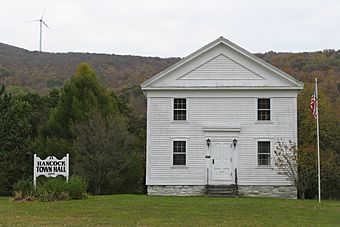Hancock Town Hall facts for kids
Quick facts for kids |
|
|
Hancock Town Hall
|
|

Hancock Town Hall
|
|
| Location | MA 43, Hancock, Massachusetts |
|---|---|
| Area | 2 acres (0.81 ha) |
| Built | 1852 |
| Architectural style | Greek Revival |
| NRHP reference No. | 73001956 |
| Added to NRHP | February 6, 1973; September 26, 1975 |
The Hancock Town Hall is a really old and important building in Hancock, Massachusetts. It's located on Massachusetts Route 43. This building was built around 1852. It was made in a special style called Greek Revival. This means it looks a bit like ancient Greek temples.
The town hall was used for many important things. It was a library, a school, and even where town leaders had their offices. People also gathered there for town meetings. In 1975, the building was moved to a new spot. This was part of the town's celebration for America's 200th birthday. The Hancock Town Hall is so special that it was added to the National Register of Historic Places in 1973. It was taken off the list for a short time after it moved. But it was put back on the list later in 1975!
Contents
What is the Hancock Town Hall Like?
The Hancock Town Hall is in the middle of Hancock. It's in a quiet, country area. You can find it on the east side of Massachusetts Route 43. It's just south of the town cemetery.
Building Design and Features
This building is made of wood and has two floors. It has a roof that slopes down on two sides, called a gabled roof. The outside walls are covered with overlapping wooden boards. These are called clapboards.
The front of the building has three sections. The main door is in the middle. Above the door is a decorative frame. Windows are on either side of the door. The windows on the first floor have slightly pointed tops. The building has simple, flat boards at its corners. These boards go up to a decorative border that wraps around the whole building. The front roof section is shaped like a triangle. It has a flat, triangular panel in its center.
History of the Hancock Town Hall
The Hancock Town Hall was built around 1852. The wood used to build it came from an old church. That church was being taken down, so the wood was reused. This town hall is one of only three buildings like it in Berkshire County. It was built specifically to be a town hall in the 1800s.
Original Location and Uses
The town hall was first located in the main part of the town. Besides being a place for town activities, it also had a private school. This school was for older students. The building was the main center for the town until 1958. After that, the town offices and meetings moved to other places.
Moving and Restoring the Town Hall
In 1973, the town decided to fix up the building. They wanted to use it for town meetings again. So, in 1975, the building was moved to where it is now. When it moved, it also got new electricity and plumbing. Because it moved, it was temporarily taken off the National Register of Historic Places. But it was put back on the list later that same year!



